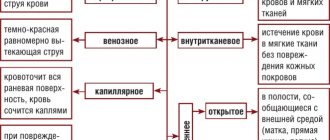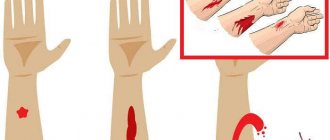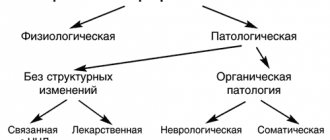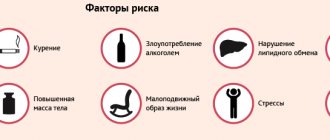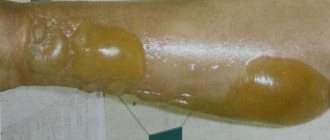Loss of consciousness is a condition caused by transient dysfunction of cerebral blood flow, causing tissue hypoxia. It manifests itself as a person’s loss of awareness of reality, loss of reflexes, lack of response to external stimulation (deafening sounds, pinching, patting the cheeks), and depression of the ganglion nervous system. The condition being examined is often a sign of various pathologies or may accompany individual ailments. There are many reasons for the disappearance of consciousness.
Sudden loss of consciousness is characterized by neurogenic etiology (epilepsy or stroke) or somatogenic (hypoglycemia, cardiac dysfunction) genesis. In addition, it can be short-lived or persistent.
Causes of loss of consciousness
The cerebral cortex is extremely sensitive to lack of oxygen. It is the starvation of the cortex that becomes the main cause of fainting. The depth and duration of fainting depends on the severity and duration of oxygen deficiency. Such fasting can develop through several mechanisms:
Cerebral ischemia
This is insufficient blood flow through the arteries due to:
- embolism, thrombosis, spasm or narrowing of the lumen of blood vessels supplying the brain by atherosclerotic plaques
- insufficient cardiac output
- or venous stagnation.
Metabolic disorders
- by type of hypoglycemia (drop in blood sugar) during fasting
- insulin overdose
- disorders of glucose utilization against the background of enzymopathies
- there may also be disturbances in protein metabolism with the accumulation of acetone-like ketone substances that poison brain cells
- This also includes various poisonings (see symptoms of food poisoning, symptoms of mercury poisoning, carbon monoxide poisoning)
Consequences and complications
The consequences of such a condition depend on the causes of its occurrence. The most serious consequences may be:
- Development of coma and cerebral edema , which leads to disorders of important life functions.
- Suffocation due to retraction of the tongue in an unconscious state.
- Various injuries received during a fall.
With frequent manifestations of this condition, a person sometimes has to change his occupation.
Classification of fainting
Depending on the main conditions of occurrence, all fainting is divided into three large groups.
- Reflex ones develop against the background of pain, severe fear, emotional stress, after coughing, sneezing, urination, when swallowing, defecation, against the background of pain in the internal organs, and during physical exertion.
- Syncope associated with orthostatic loads can occur with diabetes mellitus, amyloidosis, taking antihypertensive drugs, Parkinson's disease, a decrease in circulating blood volume, and blood retention in the veins.
- Cardiogenic are associated with diseases of the heart and blood vessels.
Diagnostics
If loss of consciousness occurs repeatedly, you should definitely consult a doctor for advice. The diagnostic program may include the following laboratory diagnostic activities:
- general and biochemical blood test;
- dopplerography;
- ultrasound examination of the heart;
- spirography;
- X-ray examination of internal organs;
- CT;
- MRI.
The exact diagnostic program will depend on the clinical picture, general history and age of the patient. Treatment will depend on the diagnosis and the etiology of this symptom.
Symptoms of fainting
The loss of consciousness is immediately preceded by a period of precursors:
- nausea, lightheadedness
- sour taste in mouth
- dizziness, flickering spots before the eyes, darkness in the eyes
- increased sweating
- hand trembling
- pallor of the skin and mucous membranes
- noise in ears.
Then a sudden loss of consciousness develops, during which the person may fall and hit himself.
- During the period of fainting, the muscles are relaxed and the body is motionless.
- The pupils are dilated and do not respond to light, the pulse is rare and superficial, breathing is slow, and blood pressure is reduced.
- During deep fainting, involuntary urination and muscle cramps may develop.
Fainting in healthy people
A completely healthy person, under certain circumstances, can bring himself to the point of fainting.
Starvation
During strict diets and fasting, the brain is deprived of glucose and triggers the metabolic pathway of starvation of the cortex. If you begin to work intensely physically on an empty stomach, it is quite possible to faint from hunger.
Abuse of sweets and simple carbohydrates
If you eat only sweets or tea with honey, then in response to carbohydrate intake, the pancreas releases a portion of insulin into the blood. Since the carbohydrate is simple, it is quickly absorbed and its concentration in the blood is quite high immediately after eating. A portion of insulin will be adequate to this blood sugar level. But then, when all the simple sugar is utilized, insulin in the blood will still work and, in the absence of sugar, will begin to decompose blood proteins. As a result, ketone bodies will enter the blood, which will work like acetone, causing metabolic disorders in the cortex and causing fainting.
Injuries
In case of injury, you can lose consciousness either from severe pain or due to bleeding. Both conditions reflexively cause centralization of blood circulation with the accumulation of the bulk of blood in the vessels of the abdominal cavity and depletion of cerebral blood flow.
Stuffy room, tight belt or collar
If you stand in clothes with a tight collar and belt for a long time in a stuffy room or transport, you may faint.
Fright
With severe fright, people with a mobile autonomic nervous system may faint. A similar thing can be observed in hysterics, who literally turn off the cortex with the power of thought and imagination.
Other reasons
- If you dive into cold water in the heat, you can cause a spasm of the neck vessels and lose consciousness.
- When a person climbs mountains or high altitudes above sea level, the partial pressure of oxygen in the blood increases. Oxygen is less efficiently utilized by cells. Oxygen starvation may occur.
- If you take a steam bath for a long time and concentrate, you can lose consciousness. A similar condition can be earned with any other heat stroke, for example, sunstroke.
- If you get sick from inhaling smoke or smoke a lot of cigarettes, you can get metabolic and hypoxic disorders in the cells of the cerebral cortex.
- Motion sickness can also cause you to lose consciousness.
- The second stage of alcohol intoxication may include not only sleep, but also fainting. Loss of consciousness after alcohol poisoning is more typical.
- More rare causes include playing wind instruments or weightlifting.
Diagnostic measures
MRI of the brain
- Cost: 14,000 rub.
More details
Diagnosis begins with an initial appointment with a neurologist. First, the doctor will try to find out in what circumstances, under the influence of what provoking factors, loss of consciousness develops. To establish a final diagnosis, you will need to undergo a series of instrumental examinations.
Thus, if cardiogenic fainting is suspected, the patient is referred for an ECG, echocardiography, and also for consultation with a cardiologist. If epilepsy is suspected, an electroencephalogram is performed. It is also common to take a blood sample to check blood sugar levels to rule out hypoglycemia. If anemia is suspected, it is necessary to conduct a blood test for hemoglobin content. If there is a possibility of neurological or organic diseases of the brain, then MRI and/or vascular examination are prescribed.
Treatment is carried out on an outpatient basis; it is enough to undergo an examination and receive treatment prescriptions.
Fainting in pregnant women
A pregnant woman should not normally faint. Although in an interesting situation, multiple prerequisites are created for the deterioration of cerebral blood flow. The uterus, stretched by the fetus, puts intense pressure not only on the internal organs, provoking venous stagnation, but also on the inferior vena cava, impairing venous return to the heart and somewhat reducing the portions of blood pushed out by the heart to the brain. Therefore, with a grown belly it is not recommended:
- independently lean forward and down
- wear tight clothes or underwear
- squeezing the neck with collars or scarves
- sleep on your back.
Immediately after childbirth, compression causes of fainting disappear.
The second most common cause of fainting in pregnant women is anemia (see pregnancy and low hemoglobin). During gestation, iron is excessively spent on the growth of the unborn baby and depletes the mother's blood of the main oxygen carrier - hemoglobin. After labor hemorrhage, anemia can not only persist, but also increase. Therefore, it is so important to correct low hemoglobin and red blood cells during pregnancy, reduce blood loss during childbirth and treat postpartum anemia (see iron supplements for anemia).
Prevention
To prevent loss of consciousness, the following rules of prevention should be followed:
- Drink enough fluids.
- Do not consume alcohol during the hot season.
- Hypertensive patients need to correctly select medications for treatment by visiting a doctor, and adequately adjust their amount.
- Do not stay in a vertical position for a long time. If there is such a need, you need to constantly shift from foot to foot, tensing your muscles.
- If you feel like you are about to pass out, you should sit or lie down immediately to help distribute blood throughout the body or at least prevent you from falling. If you can’t lie down, you should cross your arms and legs, straining your muscles at the same time.
- Avoid exposure to factors that provoke fainting. We are talking about dehydration, wearing tight clothes, overheating, severe emotional shock, etc.
- Visit your doctor in a timely manner to diagnose the development of diseases in a timely manner. It is important to properly and promptly treat illnesses that cause syncope.
- It is better to sleep in a position where your head is elevated. An additional pillow is suitable for this.
- People with vascular problems should wear compression stockings.
- It is necessary to practice adequate exercise and eat right.
Fainting woman
Gentle ladies and young ladies of past centuries considered it good form to escape from all everyday difficulties and delicate situations with the help of a banal fainting spell. This passage was facilitated by tight corsets, squeezing the ribs and making breathing difficult, dietary restrictions leading to anemia, and a mobile psyche, loosened by reading French novels. Nekrasov's and Leskov's characters of peasant and bourgeois origin suffered from fainting much less frequently, and did not experience hysterical loss of consciousness at all.
Today, women most often faint while in full health due to menstrual bleeding. This happens for the following reasons:
- neglecting to take iron-containing drugs on critical days, which prevent the development of acute posthemorrhagic anemia against the background of heavy menstruation,
- the presence of untreated gynecological or hormonal problems leading to disruption of uterine contractility and provoking menstrual pain, easily relieved with indomethacin.
Forecast
According to medical statistics, in approximately 93% of cases, benign fainting occurs with a favorable prognosis, which does not require drug treatment.
An unfavorable prognosis is observed in those patients in whom fainting is provoked by cardiovascular disease . These people are at risk of death due to heart problems. Risk factors for sudden death in patients with syncope are as follows:
- Age over 45 years.
- Ventricular arrhythmias.
- Heart failure.
- The presence of pathological changes on the ECG, which indicate arrhythmogenic disorders.
- Myocardial infarction.
- Hypertrophic cardiomyopathy.
- Arrhythmogenic right ventricular cardiomyopathy.
Fainting due to illness
Vascular diseases
Atherosclerosis, stenosis of the neck and brain vessels lead to chronic cerebral circulatory disorders, in which, along with memory, sleep and hearing disorders, periodic syncope of varying duration can be observed.
Traumatic brain injuries
Head injuries (concussions, brain contusions) are accompanied by loss of consciousness of varying depths. Fainting itself is the criterion by which express diagnosis of a concussion is carried out.
Shock
Shock (painful, infectious-toxic) is often accompanied by impaired consciousness. In case of injuries or diseases of internal organs, pain or toxins trigger a reflex chain of vascular reactions, leading to depression of the cerebral cortex.
Heart pathologies
Defects of the heart and large vessels provoke insufficient release of blood into the systemic circulation and insufficient nutrition of the brain. Acute myocardial infarction is often complicated by loss of consciousness due to a sharp drop in cardiac contractility. Also associated with syncope are severe rhythm disturbances: sick sinus syndrome, atrial fibrillation, ventricular fibrillation, transverse heart block and frequent extrasystoles. A typical rhythm disorder in which there are attacks of loss of consciousness is Morgagni-Adams-Stokes syndrome.
Pulmonary pathologies
For example, bronchial asthma leads to disturbances in gas exchange between the lungs and tissues. As a result, oxygen does not penetrate enough into the brain. Loss of consciousness is also accompanied by pulmonary embolism and pulmonary hypertension.
Diabetes
Diabetes mellitus leads to loss of consciousness due to hypoglycemia and ketoacidosis, which can quickly develop into coma. Therefore, it is so important to follow the regimen and dosage of glucose-lowering medications.
Diseases accompanied by irritation of the reflex zones of the vagus nerve
This is a peptic ulcer of the stomach and duodenum, pancreatitis, especially destructive ones, cause overirritation of the vagus nerve, which also innervates the heart. As a result, the conditions of blood supply to the cerebral cortex deteriorate.
Other reasons
- A sharp decrease in circulating blood volume due to bleeding, vomiting or diarrhea makes it impossible to adequately supply the brain with oxygen.
- Vegetative-vascular dystonia does not allow the vessels to timely and adequately adjust the lumen to the requirements of the changing external environment. The result is extremely frequent fainting due to sudden surges in pressure.
- Poisoning with neurotoxic snake venoms, alcohol and its surrogates, and organophosphorus compounds also leads to fainting
- Loss of consciousness can be a side effect of neuroleptics, hypnotics, antihypertensives, ganglion blockers, tranquilizers, and isoniazid derivatives.
- Fainting can be a consequence of uremia in renal failure.
- Increased sensitivity of carotid sinus baroreceptors can lead to syncope.
Treatment with folk remedies
The use of some folk remedies can help reduce the incidence of syncope. However, these methods are not methods of treating the causes of loss of consciousness, but only auxiliary methods to improve the condition.
- Gentian decoction. To prepare a decoction of this herb, you need to take 2 tsp. crushed raw materials and pour 1 tbsp. boiling water Drink half a glass before each meal.
- Burdock compresses. A fresh burdock leaf should be mashed and placed on the solar plexus. The compress helps you come to your senses after fainting.
- Soothing tea. It helps if a person loses consciousness due to dysfunction of the nervous system. To prepare it, you can take mint, lemon balm, St. John's wort, linden in equal proportions, mix the crushed raw materials, and 2 tbsp. l. pour 2 cups boiling water. After 20 minutes, strain and drink 2 times a day, 1 glass.
- Wormwood oil. Grind 25 g of wormwood seeds in a coffee grinder and pour in 100 g of olive oil. After a day, pour into a dark glass jar and store the product in the refrigerator. Take 2 drops 2 times a day (drop onto sugar).
- Infusion of mountain arnica. 3 tbsp. l. Pour dried arnica flowers into a thermos and pour 200 g of boiling water. After an hour, strain and drink with milk 4 times a day, adding 1 tbsp to 100 g of milk. l. infusion.
- Means for normalizing blood circulation. If loss of consciousness does occur, then after this the person should be given a glass of warm tea or chamomile decoction. Coffee or 1 tbsp will also work. l. cognac to normalize blood circulation.
- Massage of special points. In case of fainting, a massage of the points above the upper lip and under the lower lip will help revive the patient. You need to press hard on them, as sharp pain helps improve blood circulation in the brain. You can also rub the skin in the stomach area for this purpose.
- Cold water. It is sprayed on someone who has lost consciousness. This is especially important if the syncope is caused by overheating. It is recommended to cool the extremities. Also, a person who has come to his senses should drink some cold water in small sips.
How does fainting differ from loss of consciousness?
Acute thrombosis, embolism or vascular ruptures cause ischemic or hemorrhagic stroke, which can begin with loss of consciousness. In this case, loss of consciousness is longer and deeper than fainting. She could easily go into a coma.
Epilepsy accompanied by disturbances of consciousness (for example, atonic seizures) is also not quite fainting. The basis of epileptic seizures is a violation of the excitation of the nerve cells of the cortex. Which trigger an imbalance of excitation and inhibition, secondarily causing metabolic disorders in neurocytes.
Fainting | Loss of consciousness | |
| Causes |
|
|
| Duration | No more than a few minutes Usually 20-30 seconds | More than 5 minutes |
| Exit from state | Fast | Slow |
| Presence of memory loss for previous events | No | Eat |
| Restoring normal behavior and orientation | Complete and instant | Not happening or slow |
| After fainting - EEG changes | No | There is |
In any case, fainting and loss of consciousness is a reason to provide emergency assistance and then consult a doctor.
List of sources
- Bova A.A. Syncope in clinical practice: educational method. allowance. – Mn.: Asobny, 2009. – 45 p.
- Autonomic disorders: Clinic, treatment, diagnosis / ed. AM Wayne. – M., 1998. – 752 p.
- Guseva I.A., Bondareva Z.G., Miller O.N. Causes of syncope in young people // Ros. cardiology journal. - 2003. - No. 3. — P. 25-28.
- Stykan O.A. Akimova G.A. Differential diagnosis of nervous diseases: a guide for doctors. - St. Petersburg: Hippocrates, 2000. - P. 132-177.
